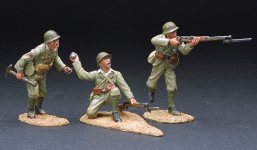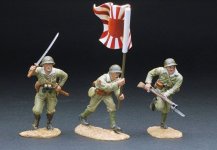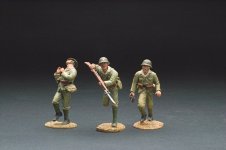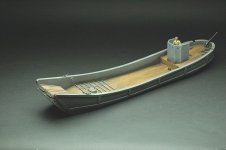From Wikipedia...
First landing attempt
Early on the morning of December 11, the garrison, with the support of the four remaining Wildcats, repulsed the first Japanese landing attempt by the South Seas Force, which included the light cruisers Yubari, Tenryū, and Tatsuta; the destroyers Yayoi, Mutsuki, Kisaragi, Hayate, Oite, and Asanagi; two old Momi class destroyers converted to patrol boats (Patrol Boat No. 32 and Patrol Boat No. 33), and two troop transport ships containing 450 Special Naval Landing Force troops.
The U.S. Marines fired at the invasion fleet with their six 5-inch (127 mm) coastal artillery guns. Major Devereux, the Marine commander under Cunningham, ordered the gunners to hold their fire until the enemy moved within range of the coastal defenses. “Battery L” commanded by Sergeant Henry Bedell on Peale islet succeeded in sinking the Hayate at a distance of 4000 yards with at least two direct hits to her magazines, causing her to explode and sink within two minutes, in full view of the defenders on shore. Yubari's superstructure was hit eleven times. The four Wildcats also succeeded in sinking another destroyer, Kisaragi, by dropping a bomb on her stern where the depth charges were stored. Both Japanese destroyers were lost with all hands, with Hayate becoming the first Japanese surface warship to be sunk during World War II. The Japanese force withdrew before landing. This was the first Japanese defeat of the war.
After the initial raid was fought off, American news media reported that when queried about reinforcement and resupply, Cunningham was reported to have quipped “Send us more Japs!” In fact, Commander Cunningham sent a long list of critical equipment—including gunsights, spare parts, and fire-control radar—to his immediate superior: Commandant, 14th Naval District. It is believed that the quip was actually padding (a technique of adding nonsense text to a message to make cryptanalysis more difficult).[7]
But the continuing siege and frequent Japanese air attacks on the Wake garrison continued, without resupply for the Americans. The initial resistance offered by the garrison prompted the Japanese Navy to detach two aircraft carriers (Sōryū and Hiryū) from the force that attacked Pearl Harbor to support the second landing attem
USN relief attempt
VMA-211 Insignia.
The projected U.S. relief attempt by Admiral Frank Fletcher's Task Force 11 (TF-11) and supported Admiral Wilson Brown’s Task Force 14 (TF-14) consisted of the fleet carrier Saratoga, the fleet oiler USNS Neches, the seaplane tender Tangier, the cruisers Astoria, Minneapolis, and San Francisco, and ten destroyers. The convoy carried the 4th Marine Defense Battalion, the VMF-221 fighter squadron equipped with F2A Brewster Buffalo fighters, along with 9,000 five-inch (127 mm) rounds, 12,000 three-inch (76.2 mm) rounds, and 3,000,000 .50 cal. (12.7 mm) rounds as well as a large amount of ammunition for mortars and other battalion small arms. Task Force 14 (TF-14) with the fleet carrier Lexington, three heavy cruisers, eight destroyers and one oiler was to undertake a raid on the Marshall Islands to divert Japanese attention.
On December 22 at 21:00, after receiving information indicating the presence of two IJN carriers and two fast battleships near Wake Island Vice Admiral William S. Pye, the Acting Commander in Chief of the U.S. Pacific Fleet, ordered TF-14 to return to Pearl Harbor.[8]for fear of losses. (At the Battle of Midway Pye ordered battleships to patrol from the West Coast-in case of a Japanese attack; after Wake and Midway he never commanded forces in battle again).
Second assault
Captain Henry T. Elrod, KIA, Medal of Honor recepient
Wreckage of Wildcat 211-F-11, flown by Captain Henry T. Elrod on December 11 in the attack that sank the Japanese destroyer Kisaragi.{211 for "Squadron 211"; F for "Fighter"; 11 for eleventh plane}
Wake Island Device
The second Japanese invasion force came on December 23, composed mostly of the same ships from the first attempt with some new additions, plus 1,500 Japanese marines. The landings began at 02:35 where, after a preliminary bombardment, the ex-destroyers Patrol Boat No. 32 and Patrol Boat No. 33 were beached and burned in their attempts to land the invasion force. After a full night and morning of fighting, the Wake garrison surrendered to the Japanese by mid-afternoon.
The U.S. Marines lost 47 killed and 2 MIA during the entire 15-day siege, while three U.S. Navy personnel and at least 70 civilians were killed {besides the 10 Chamorros}. Japanese losses were recorded at between 700 to 900 killed, with at least 1,000 more wounded, in addition to the two destroyers lost in the first invasion attempt and at least 28 land-based and carrier aircraft either shot down or damaged. The Japanese captured all men remaining on the island, the majority of whom were civilian contractors employed with Morrison-Knudsen Company.
Captain Henry T. Elrod, one of the pilots from VMF-211, was awarded the Medal of Honor posthumously for his action on the island during the second landing attempt, having shot down two Japanese A6M Zero fighters, and sunk the Japanese destroyer Kisaragi. A special military decoration, the Wake Island Device, was also created to honor those who had fought in the defense of the island.
Michael







